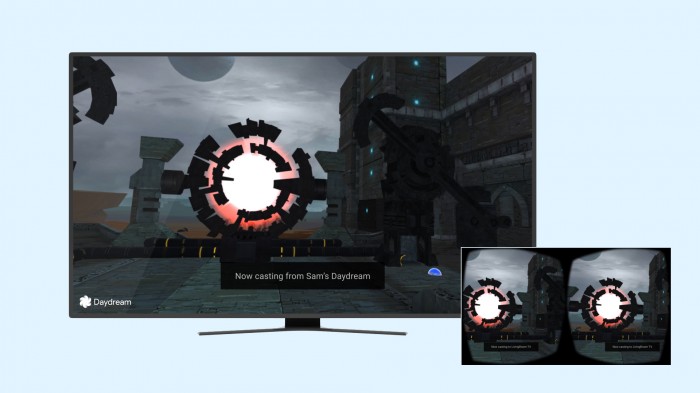Google Thinks It Has Cracked the VR Adoption Problem

For most consumers, virtual reality is still a technology of the future. Google hopes that by making the virtual world more convenient and accessible, more people will want to dive in.
This was the overarching message at the company’s annual developer conference this week in Mountain View, California, where executives like Clay Bavor, who leads virtual and augmented reality efforts, laid out what’s coming next for its Daydream VR platform—including powerful wireless headsets that can track your head position and orientation without special external sensors, and software changes that encourage users to spend more time in VR while sharing what they’re doing with others and not missing out on other things they may want to know about.
Altogether, the updates, coupled with Google’s clout as a leader in many technology spaces (search, Web browsing, mobile, to name a few) could mark a huge change in the visibility and uptake of virtual reality over time. And if it doesn’t work, it could be a huge setback for virtual reality—if not the end of it entirely.
Google has already put in a lot of work and money in hopes of bringing virtual-reality technology to the mainstream, through efforts like Google Cardboard—a foldable VR viewer that works with a smartphone—and, more recently, the more capable but still phone-dependent Daydream VR platform.
Yet while over 10 million of the Cardboard viewers have shipped since it was released in 2014, and there are about 150 apps out for the Google-made Daydream headset that shipped late last year, consumer adoption has been slow going. About 10 million headsets shipped globally last year, according to IDC, a market researcher, which is just a tiny fraction of the 1.5 billion smartphones that shipped in the same time frame.
There are lots of reasons why people aren’t buying into the technology. It’s isolating, and there aren’t a ton of things to do. All of the high-end headsets need to be connected to a computer or gaming console, and it’s annoying to feel cords flying around on your back and shoulders when you’re trying to forget about actual reality and explore, say, Mars in VR. And it’s expensive—a typical headset and its required computing platform will cost you anywhere from about $750 to well over $1,000, depending on what you’re buying.
Google is chipping away at the clunky and expensive issues by working with chipmaker Qualcomm to come up with a reference design for a wireless VR headset, and the company says that HTC and Lenovo are working with Google and building VR headsets like this.
The first of these headsets is expected to be available later this year, and Mike Jazayeri, Daydream’s director of product management, expects they will be priced similarly to desktop-connected VR devices today, minus the price of a PC—so, probably around $600 to $800.
“There’s just less friction. Put the headset on and you’re ready to go,” Jazayeri said.
I got to try an older prototype of one of these headsets this week, watching a short scene from the Star Wars film Rogue One to show off another innovation Google will roll out—a software tool called Seurat that can show desktop-computer-quality graphics on mobile VR devices by simplifying a given scene, computation-wise. The headset was fairly comfortable, with a wheel-style adjustment on the back of my head, and the imagery looked impressively crisp, even when I spun around or kneeled down on the ground to see the reflections better on the shiny virtual floor. When I moved too far in one direction or another, the world around me darkened to let me know I shouldn’t go any farther.
Google’s wireless plan could be a big deal for the VR industry. While several wireless virtual-reality headsets have been shown off that seek to marry high-end visuals and head tracking with a wireless design, they haven’t come out yet, and the ones that are wireless, like Google’s existing Daydream View and Samsung’s Gear VR, aren’t nearly as capable and won’t work without a really good smartphone.
Google is also making its software simpler and more comfortable. For instance, Daydream will add a dashboard so you can see Android notifications and settings without leaving VR, said Jazayeri. And he said it will start letting you share a two-dimensional view on, say, a TV screen of what you’re seeing in your VR headset with other people in the room—an effort to make the technology feel less isolating for those who are using it and more inclusive of those who aren’t.
Google hopes that these moves, plus others like a group 360-video-watching experience that YouTube will launch later this year and a plan to launch Google’s Chrome browser in virtual reality, could make users more interested in trying virtual reality and make it feel more familiar, too.
Keep Reading
Most Popular
Large language models can do jaw-dropping things. But nobody knows exactly why.
And that's a problem. Figuring it out is one of the biggest scientific puzzles of our time and a crucial step towards controlling more powerful future models.
The problem with plug-in hybrids? Their drivers.
Plug-in hybrids are often sold as a transition to EVs, but new data from Europe shows we’re still underestimating the emissions they produce.
Google DeepMind’s new generative model makes Super Mario–like games from scratch
Genie learns how to control games by watching hours and hours of video. It could help train next-gen robots too.
How scientists traced a mysterious covid case back to six toilets
When wastewater surveillance turns into a hunt for a single infected individual, the ethics get tricky.
Stay connected
Get the latest updates from
MIT Technology Review
Discover special offers, top stories, upcoming events, and more.